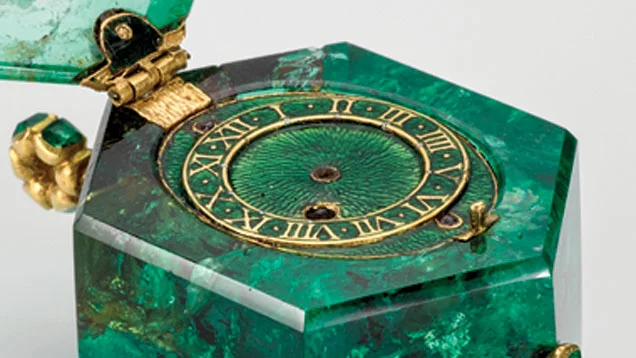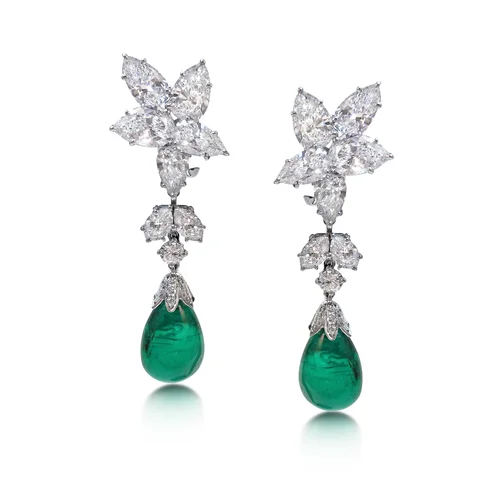Let's Talk About Emeralds
“No stone has a colour that is more delightful to the eye, there being no green in existence more intense than this" - Pliny the Elder
An emerald watch, with the large hexagonal crystal cut out and fitted with a Swiss watch movement, circa 1600. One of the treasures found amongst a group of 17th century and earlier jewels in London, known as The Cheapside Hoard. Image courtesy of gia.edu.
The earliest reference that we know of was found in an Egyptian papyrus dating to 2500 BC, and in it was written 'wise words are rarer than emeralds'. With one of the richest histories and appreciation amongst gemstones, the emerald is considered the oldest and first recorded gem of the 'Big Four' - Emerald, Ruby, Sapphire and Diamond.
Cleopatra, the last Pharaoh of Egypt had such a deep passion for emeralds that the first emerald mines in Egypt were named after her. As a symbol of power, she would present to foreign statesmen, carved emeralds in her image. The Incas worshipped their goddess by filling their temples with emeralds. To the Mughals, the green of the emerald represented paradise. Green is also the official colour of Islam. Given such associations, fine emeralds became one of the most desirable trade commodities throughout vast stretches of the world.
What exactly is an emerald then? It is a variety of the mineral beryl, coloured green by chromium and vanadium. Chemically known as beryllium aluminium cyclosilicate Be3Al2(SiO3)6, it has a hardness (resistance to scratching) of 7.5 - 8 on the Mohs Scale, and their toughness (resistance to breakage) poor.
When choosing a diamond, we look at the 5Cs - Colour, Clarity, Cut, Carat and Certification. With an emerald, we consider two additional factors, Origin and Treatment.
Colour
Vivid green, preferably, with a lot of depth (hue, tone, saturation). Neither too dark nor too pale (tone), and evenly distributed (saturation) throughout the gemstone. Traditionally emerald green should be the perfect balance of blue and yellow – a pure green hue. The appraisal and appreciation of colour is, of course, subjective to some extent.
Clarity
A gemstone's clarity has to do with the number of inclusions that it contains, the size of those inclusions and their position within the gemstone. The fewer, smaller and less conspicuous the inclusions, the better.
It is, however, extremely unusual to find a “clean” emerald. Almost all contain imperfections, known as jardins (French for gardens because they resemble plants and trees), which are visible to the naked eye. Inclusions could come in solid, liquid or gaseous state and also include fractures/breaks. These may be embedded crystals of other minerals, growth lines, cleavages or tiny fractures that are entirely natural. They are, indeed, a kind of code – one that can reveal the story of the gemstone’s origin and its subsequent migration from subterranean darkness to the light of day. As such they may be thought to possess their own kind of beauty.
Emeralds which feature three-phase inclusions are distinctive in appearance. Displaying (1) the jagged outline of a space filled with liquid (2) a small square-shaped crystal and (3) a rounded gas bubble, these emeralds are more often than not from Colombia and Brazil.
Inclusions: The clarity of a gemstone is determined by the number, size and location of inclusions which are present in the gemstone. They reflect its fascinating geological aspects. Internally and externally too, there may be the presence of fissures, fractures and cavities which affect clarity.
Transparency refers to the ability of a gemstone to transmit light. It is affected by the quantity or absence of opacity and brilliance present in the gemstone.
Cut
While emerald is a relatively hard gemstone measuring about 7.5 or 8 on the industry-standard Mohs scale (talc is 1 and diamond is 10), it is also brittle, and this, together with the presence of jardins, can make it a challenging gemstone to cut. The so-called emerald cut – rectangular or square, with bevelled edges – was specially developed to show emeralds off to best advantage while minimising the risk of fracturing or chipping. However, emeralds are also available in cushion, oval and pear cuts. Recently the smooth, dome-shaped cabochon cut has become popular, as have non-traditional slices and rough cuts.
If an emerald is well cut, it will mask colour variation, inclusions and other imperfections, and not create “extinctions” (dark patches). Badly cut gemstones tend to maximise weight at the expense of brilliance. Indeed, badly cut gemstones tend to be bad gemstones in the first place – they are not worth the time it takes to cut them well. By contrast, a high-quality gemstone will almost always be well cut. When polished well the gemstone should also possess good lustre – in the case of emerald, the desired quality is known as “vitreous”.
Carat
All gemstones are measured in weight by carats, wherein 1 carat is equivalent to 0.2 grams. However, due to differing densities of the various gemstones, a 1 carat emerald will not appear to be the same size as a 1 carat diamond. When comparing the densities of the emerald, diamond and ruby; the emerald is the least dense, followed by diamond, and finally ruby (or sapphire). Therefore a 1 carat emerald will appear largest, and the ruby smallest.
Treatment
Emeralds are nearly always oiled to enhance their colour and mask inclusions, and there is nothing untoward about this centuries-old process. It does no damage to the gemstone and its effects are not permanent – the oil will dry out eventually. The presence of oil may be revealed in a slight iridescence on the surface of the gemstone or one that may be seen inside the gemstone when viewed under a bright light – though iridescence within an emerald can also occur naturally.
Check for concentrations of dye in any cracks in the gemstone – dye is used to improve inconsistent or weak colour.
Emeralds with significant fissures are sometimes filled with a resin or polymer to improve clarity. If so, flashes of orange or blue may be noticed when the gemstone is inspected under a bright light – to an experienced eye, they are fairly easy to spot. It is important to know about fillings, as they can be dislodged during setting or cleaning.
The presence of joining lines along the edges could reveal a “composite” emerald. If in doubt, put the gemstone in water – you will see a distinct line at the join.
The extent to which an emerald has been treated will affect its value – an emerald with good natural colour and clarity will always be more valuable than one whose qualities have been artificially enhanced. Treatments may also affect the gemstone’s longevity, since emerald is brittle to begin with, and those with fillings may be less durable. So any treatments that a gemstone has undergone must be fully disclosed at the point of sale.
Origin
Emeralds were first mined in Egypt, Pakistan and Austria, but can also now be found in Zambia, Zimbabwe, Tanzania, Madagascar, Nigeria, Afghanistan, Russia, Bulgaria, Canada, China, and Norway. However, since the 16th century, Colombia remains the location where the most famous emeralds are mined. Remaining the world leader in emerald production, Colombian diamonds command the highest emerald prices.
Certification
In terms of certification, a report from a licensed gemological laboratory can confirm the characteristics and qualities of your gemstone, including not only its colour, clarity, weight and dimensions but also its origin (when known) and any artificial treatments to which it might have been subjected. Don’t be shy about asking for the documentation to support the claims a seller makes for a gemstone. The best-known laboratories to issue such certification are the GÜBELIN GEM LABORATORY, the SWISS GEMMOLOGICAL INSTITUTE (SSEF) and the AMERICAN GEMOLOGICAL LABORATORIES (AGL).
From L-R: An Antique Emerald and Diamond Necklace and Earrings Set, circa 1890; An Antique 4.34 Carat Emerald and Diamond Cluster Ring; A Pair of Emerald and Diamond Earclips, by Bulgari; A Pair of Emerald and Diamond Earrings, by Harry Winston, circa 1950. All available at Revival Vintage Jewels and Objects.
Original article can be found at http://consumer.gemfields.co.uk/guide/emerald








